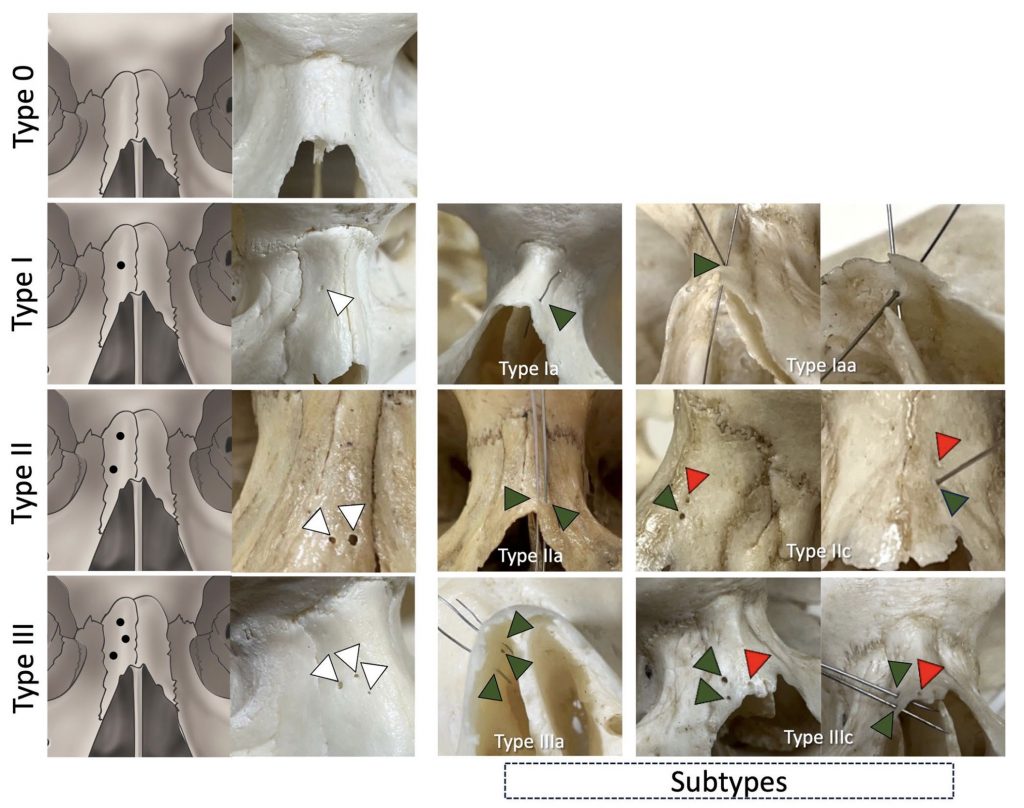Highlight
การศึกษาพบว่ารูเปิดกระดูกจมูกประเภท I (หนึ่งรูเปิดภายนอก) เป็นประเภทที่พบมากที่สุด การทำความเข้าใจลักษณะทางกายวิภาคของรูเปิดนี้ช่วยเพิ่มความแม่นยำในการรักษาทางคลินิก เช่น การผ่าตัดและการฉีดยาบริเวณจมูก

ชื่องานวิจัย ภาษาไทย
การศึกษากายวิภาคของรูเปิดกระดูกจมูก
ที่มาและความสำคัญ
รูเปิดของกระดูกจมูก (nasal foramen) เป็นโครงสร้างทางกายวิภาคที่สำคัญสำหรับการส่งผ่านเส้นเลือดและเส้นประสาทไปยังบริเวณจมูก โดยรูเปิดนี้สามารถพบในตำแหน่งและลักษณะที่หลากหลายในกระดูกจมูก การศึกษานี้ได้สำรวจประเภทและลักษณะของรูเปิดกระดูกจมูกในกะโหลกศีรษะแห้งจากประชากรไทยและอเมริกัน โดยมีการจัดประเภทและวัดขนาดรูเปิด พบว่าประเภท I (หนึ่งรูเปิดภายนอก) เป็นประเภทที่พบได้บ่อยที่สุด ผลการศึกษาเน้นถึงความสำคัญของการทำความเข้าใจโครงสร้างรูเปิดนี้ เพื่อประยุกต์ใช้ในทางคลินิก เช่น การผ่าตัดและการฉีดยาบริเวณจมูก
Abstract
Purpose
The nasal foramen is located in the nasal bone and for vessels passage to supply the nasal area. This project aimed to establish reliable references for the nasal foramina for future clinical applications.
Methods
The 72 dried skulls, 46 from the Division of Anatomy, University of Phayao, Thailand, and 26 from the Tulane University School of Medicine, USA, were collected and examined. The location, number, and sizes of nasal foramina were noted. The distances from each nasal foramen to the internasal suture, frontonasal suture, nasomaxillary suture, nasion, and rhinion were also recorded and used in the statistical analytical programs.
Results
The most common type of nasal foramen in all skulls was type II (one external opening) at 65.97%, followed by type I (no foramen opening) at 20.83%, type III (two external openings) at 11.11% and type IV at 2.08% (three external openings). Nasal foramen subtypes in many of the Thai and American skulls were type IIb and type IIa. The diameter of a connecting nasal foramen was significantly larger than that of a non-connecting. Results from embalmed confirmed the passage of the external nasal artery through the nasal cavity.
Conclusion
The study shows no significant difference in nasal foramen morphometry between Thai and American. It illustrates recent data on type and subtype classifications and the location of a vascular passage through the nasal foramen. This is the first study of NF variations and their respective classifications.
KEYWORDS: Nasal foramen, Nasal bone, Vascular passage, Anatomy, Face
Citation: Chaiyamoon, A., Boontem, P., Samrid, R., Cardona, J. J., Khanthiyong, B., Yurasakpong, L., Iwanaga, J., & Tubbs, R. S. (2024). An anatomical study of the nasal foramina. Surgical and Radiologic Anatomy, 46(1495–1500).
DOI: https://doi.org/10.1007/s00276-024-03414-w
RELATED SDGs:
3. GOOD HEALTH AND WELL-BEING

ผู้ให้ข้อมูล: ผู้ช่วยศาสตราจารย์ ดร.อธิคุณ สุวรรณขันธ์
ชื่ออาจารย์ที่ทำวิจัย: อาจารย์ ดร.ลภัสรดา ยุรศักดิ์พงศ์
Credit ภาพ: อาจารย์ ดร.ลภัสรดา ยุรศักดิ์พงศ์
Webmaster: ว่าที่ ร.อ. นเรศ จันทรังสิกุล
Tags: Anatomy, Face, nasal bone, Nasal foramen, Vascular passage
